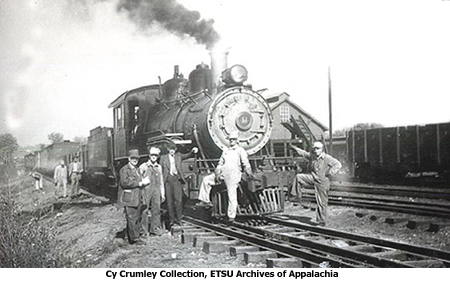The Jan. 1951 edition of Trains magazine (Kalmbach Publishing Co.) contained a most attention-grabbing article about the East Tennessee and Western North Carolina (ET&WNC) Railway abandoning the narrow gauge portion of its line.
Writer Jack Alexander had the enviable opportunity to ride “Tweetsie” on Oct. 16, 1950 as it made its last official roundtrip run between Elizabethton and Cranberry, NC. At 10:10 a.m. in near perfect weather, Jack boarded the seven-car train, pulled by Baldwin 4-6-0 engine No. 11. His description of the train’s noisy departure was “with a whistle screaming and a feather (puff of white steam) on the pops (above the safety valves).”

Jack identified train personnel as Walter R. Allison, engineer; C.C. (Brownie) Allison, fireman; Clyde Simmerly and Mack Luttrell, brakemen; and C.G. “Cy” Crumley, conductor. Cy then swung the “highball,” indicating the train had received priority to proceed at safe full speed and began moving uphill at a rapid pace, heading for treacherous 4% elevation grades and 32-degree curves.
“Tweetsie” journeyed across a bridge into Valley Forge, up the valley, over a covered bridge and into a tunnel below Hampton. The wheels seemed to mournfully click out memories of the many hours the riders had spent riding this popular train when there were three daily round-trip passenger runs, traveling over 34 miles of track in two states. A feeling of sadness encompassed Alexander; he felt like he was riding a funeral train with “Tweetsie” being the deceased. Although World War II brought about a demand for more ore, postwar circumstances of depleted mines and declining timber reserves caused a gradual decline in rail traffic.
After briefly stopping in Hampton, the train soon entered the magnificent Doe River Gorge. After additional stops at Blevins and Roan Mountain, “Tweetsie” rested at Elk Park at 12:15 p.m. to give passengers a lunch break. The crew ate with guarded conversations and far away looks in their eyes; a sense of stoic nostalgia had overwhelmed them. After lunch, the crew did some switching in the yard and then boarded the train for its remaining two miles to Cranberry, NC. After spotting Engine No. 11 for water at the Cranberry tank, “Tweetsie” began her final return trip to Elizabethton. It was 1:30 p.m.
As always, the engine was not turned at the east end of the line, but instead, run in reverse at the head end of the train for the remainder of the journey. Alexander climbed upon the tender car and rode the water-hatch cover for a better view of the local terrain. The train then dropped down the hill across the Tennessee border into Shell Creek and on to Roan Mountain and Blevins. As Jack sat there thinking of bountiful past years and pleasurable associations with the crew, Tweetsie bounced through several tunnels and rattled across numerous bridges.
Consistent with a longstanding tradition since 1882, local residents sadly ran out of their modest homes to tearfully wave goodbye to the crew and watch their favorite train chug by one final time. “Tweetsie” suddenly reduced speed as it crept around Pardee Point, dropped down and out of the gorge, crossed the covered bridge, traveled through Hampton, sped across the high bridge over the river and entered Valley Forge.
Alexander abruptly concluded his article with these words: “Extra 11 West entered the yards at Elizabethton at 3:30 p.m. The crew made a Dutch drop to get the cars in the yard, then ran No. 11 over the pit and dropped the fire. Tweetsie’s last ride was over.”
